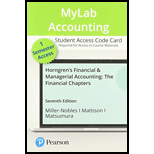
1.
Introduction:
To record: The opening balance in T-accounts.
2.
Introduction: Journal entry is the first step of accounting to record day-to-day transactions that a business performs. It helps in further preparing financial statements at the end of the period to assess the financial position of the business.
To record: The journal entries and prepare T-accounts.
3.
Introduction: Journal entry is the first step of accounting to record day-to-day transactions that a business performs. It helps in further preparing financial statements at the end of the period to assess the financial position of the business.
To record: The journal entries and prepare T-accounts.
Want to see the full answer?
Check out a sample textbook solution
Chapter 4 Solutions
MYLAB (24 MONTHS) (FIN)
- Please help me solve this general accounting question using the right accounting principles.arrow_forwardPlease provide the accurate answer to this general accounting problem using valid techniques.arrow_forwardPlease provide the accurate answer to this general accounting problem using appropriate methods.arrow_forward
 Intermediate Accounting: Reporting And AnalysisAccountingISBN:9781337788281Author:James M. Wahlen, Jefferson P. Jones, Donald PagachPublisher:Cengage LearningPrinciples of Accounting Volume 1AccountingISBN:9781947172685Author:OpenStaxPublisher:OpenStax College
Intermediate Accounting: Reporting And AnalysisAccountingISBN:9781337788281Author:James M. Wahlen, Jefferson P. Jones, Donald PagachPublisher:Cengage LearningPrinciples of Accounting Volume 1AccountingISBN:9781947172685Author:OpenStaxPublisher:OpenStax College

